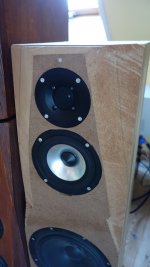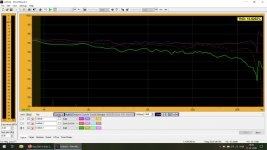Indeed. Maybe it's because it takes some extra care in the design proces, when building the speaker, choosing drivers and creating a good filter/EQ.So many seem to ignore this...
Not easy, but very much worth the effort IMO 🙂
I would rather have some basic drivers in an active setup with proper speaker cabinets, than fancy expensive driver in a poorly designed cabinet with bad x-overs and no EQ.
I still find FR to be the most important factor - also off-axis. I have still not heard FIR to be any improvement.... even though I would wish so. Just happy that I do not find it to be so.... cause I run IIR 😀
Last edited:
Well, because it's high dispersion you see, more so than the H1212. Maybe "replacement" is the wrong word usage, how about "modern interpretation of a high dispersion tweeter"
It’s not high-dispersion. It only looks that way because of the breakup right past 20 kHz. From about 15-18 kHz (I’m not looking at the graph right now) the off-axis response is trending downward substantially.
You see the same effect on many rigid domes, such as the SB26ADC (though that one isn’t quite apples-to-apples since there’s a phase shield - but augerpro has good measurements of the unit without a shield)
Last edited:
It’s not high-dispersion. It only looks that way because of the breakup right past 20 kHz. From about 15-18 kHz (I’m not looking at the graph right now) the off-axis response is trending downward substantially.
The 30 degree is pretty up there as compared to the on axis. The 60 degree is down by quite a bit... that being said, who listens to their speakers at 60 degrees😛
Yes, that is the effect of the dome breakup, it tends to broaden the dispersion due to the radiating "bits" of the dome no longer accelerating in phase (starting around 15 kHz with this one). You can see this phenomenon in both the 30-degree and 60-degree plots. If you took away the dome breakup the off-axis response would only continue to trend downward. This tweeter has no features to improve off-axis response; no phase plug / phase shield, not a smaller dome, no diffraction elements, etc.
As you even acknowledge, the 60 degree plot is quite far down, which wouldn't be the case if it were "high-dispersion". Look at the off-axis plots for a typical 3/4" dome tweeter to compare.
Bit of an exaggeration, but would you call this tweeter high-dispersion as well? https://hificompass.com/sites/default/files/documents/T34B-4_datasheet.png
Bottom line - not a high-dispersion tweeter, just a "normal" tweeter.
As you even acknowledge, the 60 degree plot is quite far down, which wouldn't be the case if it were "high-dispersion". Look at the off-axis plots for a typical 3/4" dome tweeter to compare.
Bit of an exaggeration, but would you call this tweeter high-dispersion as well? https://hificompass.com/sites/default/files/documents/T34B-4_datasheet.png
Bottom line - not a high-dispersion tweeter, just a "normal" tweeter.
Last edited:
Seas states the p-p to be 0,4mm but that it can be crossed at 1800Hz, I assume 4th order. However, I find it hard to believe it could be pushing many watts with such a crossover. Was 1,8K maybe a bit optimistic?
As you even acknowledge
Wow calm down there mister. I'm not trying to deny anything. I too can sure as hell tell that this tweeter isn't some omnidirectional leaf driver. As I said, the 30 degree response is basically the same as the on axis. Many drivers doesn't sport such a 30 degree dispersion.
Regardless, last time checked "high dispersion tweeter" wasn't a protected title that only a few select tweeters was to be described with.
I xover'd at 1.8kHz (3rd elec/4th acoustic), and it is handling it quite well.
Wolf
Do you know what the maximum wattage to the larger drivers were? I'd like it to handle atleast 100 watts.
I have not mapped the power handling for my design, but suffice to say it will get quite loud before either driver remotely starts to bark.
My clean model before baffle step was looking at 109dB with 70W into the pair of 5.25" woofers. This means with full comp, the output would be about 103dB. I don't think you'll want for output, and Xmax is not even a concern thus far.
Later,
Wolf
My clean model before baffle step was looking at 109dB with 70W into the pair of 5.25" woofers. This means with full comp, the output would be about 103dB. I don't think you'll want for output, and Xmax is not even a concern thus far.
Later,
Wolf
Last edited:
My H1212's do -8dB on 60 degrees (flat baffle 24cm wide) at 10kHz. It's not the breakup actually (27kHz), but the pathway difference that causes cancellation. At 10k wavelength is 3,4cm and half wavelength (i.e. out of phase) 1,7cm. That off axis behavior pretty much has to be expected from any 1" tweeter, even those with a flat dome profile.It’s not high-dispersion. It only looks that way because of the breakup right past 20 kHz. From about 15-18 kHz (I’m not looking at the graph right now) the off-axis response is trending downward substantially.
You see the same effect on many rigid domes, such as the SB26ADC (though that one isn’t quite apples-to-apples since there’s a phase shield - but augerpro has good measurements of the unit without a shield)
- Home
- Loudspeakers
- Multi-Way
- Seas 27TAC/GB, the DXT replacement

